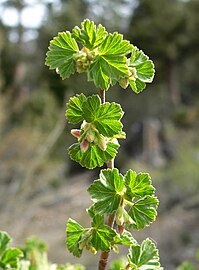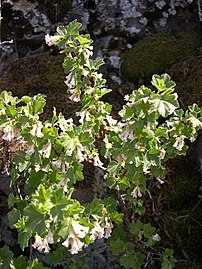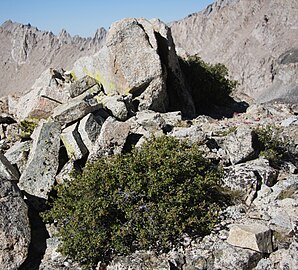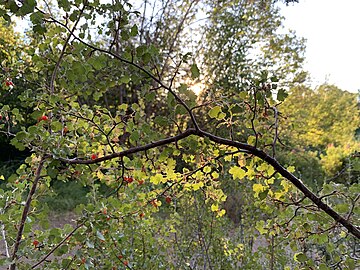Ribes cereum
| Wax currant | |
|---|---|

| |
| Ribes cereum var. cereum, from the Spring Mountains, southern Nevada | |
| Scientific classification | |
| Kingdom: | Plantae |
| Clade: | Tracheophytes |
| Clade: | Angiosperms |
| Clade: | Eudicots |
| Order: | Saxifragales |
| Family: | Grossulariaceae |
| Genus: | Ribes |
| Species: | R. cereum
|
| Binomial name | |
| Ribes cereum | |
| Varieties | |
|
Ribes cereum var. colubrinum C.L.Hitchc. [2] | |
Ribes cereum is a species of currant known by the common names wax currant[7] and squaw currant;[8] the pedicellare variety is known as whisky currant. The species is native to western North America.
Description
Ribes cereum is a spreading or erect
The plant is aromatic, with a spicy scent.[9] The hairs on much of the plant can contribute to a carrion-like odor.[8]
-
April growth in the Spring Mountains, southern Nevada
-
Flowering in southwest Idaho
-
Plant at 12,500 ft (3,800 m), Sierra Nevada, California
-
Tumalo State Park, Oregon
-
Branch in Bend, Oregon, backlit by sun
-
Berries with dried flower remnant
Distribution and habitat
The species is native to western North America, including
It grows in several types of habitat, including mountain forests in
Ecology
The berries are a significant food source for deer[8] and are consumed by other animals.[12]
Uses
Some Native American tribes ate the berries.[13] The Zuni people eat the berries of the pedicellare variety, as well as the leaves with uncooked mutton fat or deer fat.[14] One field guide reports that the berries are somewhat toxic and can have an unpleasant flavor.[15] Eating too many may cause a burning feeling in the throat.[8] One source says they are good when ripe, and can be made into jam or pie fillings.[13]
References
- ^ This species was first described and published in Trans. Hort. Soc. vii. (1830) 512. "Plant Name Details for Ribes cereum". IPNI. Retrieved July 20, 2010.
- ^ Vascular Plants of the Pacific Northwest 3: 69. 1961. "Plant Name Details for Ribes cereum var. colubrinum". IPNI. Retrieved July 20, 2010.
- ^ Mém. Soc. Phys. Genève 35: 338. 1907. "Plant Name Details for Ribes cereum var. farinosum". IPNI. Retrieved July 20, 2010.
- ^ Bot. California [W.H.Brewer] 1: 207. 1876. "Plant Name Details for Ribes cereum var. pedicellare". IPNI. Retrieved July 20, 2010.
- ^ Mém. Soc. Phys. Genève 35: 338. 1907. "Plant Name Details for Ribes cereum var. viridescens". IPNI. Retrieved July 20, 2010.
- ^ "Ribes cereum var. inebrians". University and Jepson Herbaria Home Page. 2022-06-19. Retrieved 2022-06-19.
- ^ USDA, NRCS (n.d.). "Ribes cereum". The PLANTS Database (plants.usda.gov). Greensboro, North Carolina: National Plant Data Team. Retrieved 22 October 2015.
- ^ OCLC 25708726.
- ^ a b c Flora of North America, Ribes cereum
- ^ Biota of North America Program 2014 county distribution map
- ^ US Forest Service Fire Ecology
- ^ "Ribes cereum". U.S. Forest Service. Retrieved 2022-08-01.
- ^ OCLC 668195076.
- ^ Stevenson, Matilda Coxe 1915 Ethnobotany of the Zuni Indians. SI-BAE Annual Report #30 (p. 70)
- OCLC 61461560.
External links
- Jepson Manual Treatment
- University of Washington, Burke Museum
- photo of herbarium specimen at Missouri Botanical Garden, collected in Idaho in 2014
- "Ribes cereum". Plants for a Future.
- Ribes cereum in the CalPhotos photo database, University of California, Berkeley






